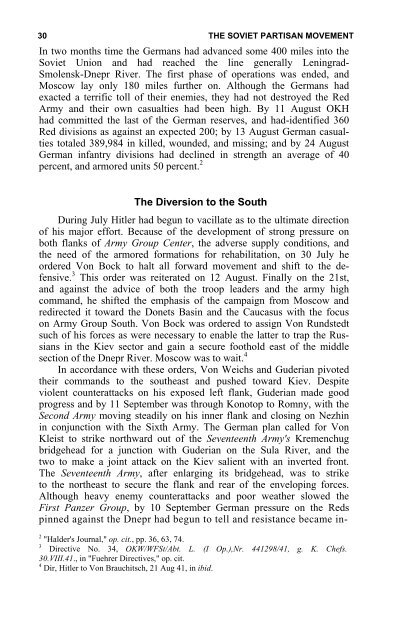the soviet partisan movement 1941-1944 by edgar m. howell
the soviet partisan movement 1941-1944 by edgar m. howell
the soviet partisan movement 1941-1944 by edgar m. howell
Create successful ePaper yourself
Turn your PDF publications into a flip-book with our unique Google optimized e-Paper software.
30 THE SOVIET PARTISAN MOVEMENT<br />
In two months time <strong>the</strong> Germans had advanced some 400 miles into <strong>the</strong><br />
Soviet Union and had reached <strong>the</strong> line generally Leningrad-<br />
Smolensk-Dnepr River. The first phase of operations was ended, and<br />
Moscow lay only 180 miles fur<strong>the</strong>r on. Although <strong>the</strong> Germans had<br />
exacted a terrific toll of <strong>the</strong>ir enemies, <strong>the</strong>y had not destroyed <strong>the</strong> Red<br />
Army and <strong>the</strong>ir own casualties had been high. By 11 August OKH<br />
had committed <strong>the</strong> last of <strong>the</strong> German reserves, and had-identified 360<br />
Red divisions as against an expected 200; <strong>by</strong> 13 August German casualties<br />
totaled 389,984 in killed, wounded, and missing; and <strong>by</strong> 24 August<br />
German infantry divisions had declined in strength an average of 40<br />
percent, and armored units 50 percent. 2<br />
The Diversion to <strong>the</strong> South<br />
During July Hitler had begun to vacillate as to <strong>the</strong> ultimate direction<br />
of his major effort. Because of <strong>the</strong> development of strong pressure on<br />
both flanks of Army Group Center, <strong>the</strong> adverse supply conditions, and<br />
<strong>the</strong> need of <strong>the</strong> armored formations for rehabilitation, on 30 July he<br />
ordered Von Bock to halt all forward <strong>movement</strong> and shift to <strong>the</strong> defensive.<br />
3 This order was reiterated on 12 August. Finally on <strong>the</strong> 21st,<br />
and against <strong>the</strong> advice of both <strong>the</strong> troop leaders and <strong>the</strong> army high<br />
command, he shifted <strong>the</strong> emphasis of <strong>the</strong> campaign from Moscow and<br />
redirected it toward <strong>the</strong> Donets Basin and <strong>the</strong> Caucasus with <strong>the</strong> focus<br />
on Army Group South. Von Bock was ordered to assign Von Rundstedt<br />
such of his forces as were necessary to enable <strong>the</strong> latter to trap <strong>the</strong> Russians<br />
in <strong>the</strong> Kiev sector and gain a secure foothold east of <strong>the</strong> middle<br />
section of <strong>the</strong> Dnepr River. Moscow was to wait. 4<br />
In accordance with <strong>the</strong>se orders, Von Weichs and Guderian pivoted<br />
<strong>the</strong>ir commands to <strong>the</strong> sou<strong>the</strong>ast and pushed toward Kiev. Despite<br />
violent counterattacks on his exposed left flank, Guderian made good<br />
progress and <strong>by</strong> 11 September was through Konotop to Romny, with <strong>the</strong><br />
Second Army moving steadily on his inner flank and closing on Nezhin<br />
in conjunction with <strong>the</strong> Sixth Army. The German plan called for Von<br />
Kleist to strike northward out of <strong>the</strong> Seventeenth Army's Kremenchug<br />
bridgehead for a junction with Guderian on <strong>the</strong> Sula River, and <strong>the</strong><br />
two to make a joint attack on <strong>the</strong> Kiev salient with an inverted front.<br />
The Seventeenth Army, after enlarging its bridgehead, was to strike<br />
to <strong>the</strong> nor<strong>the</strong>ast to secure <strong>the</strong> flank and rear of <strong>the</strong> enveloping forces.<br />
Although heavy enemy counterattacks and poor wea<strong>the</strong>r slowed <strong>the</strong><br />
First Panzer Group, <strong>by</strong> 10 September German pressure on <strong>the</strong> Reds<br />
pinned against <strong>the</strong> Dnepr had begun to tell and resistance became in-<br />
2 "Halder's Journal," op. cit., pp. 36, 63, 74.<br />
3<br />
Directive No. 34, OKW/WFSt/Abt. L. (I Op.),Nr. 441298/41, g. K. Chefs.<br />
30.VIII.41., in "Fuehrer Directives," op. cit.<br />
4 Dir, Hitler to Von Brauchitsch, 21 Aug 41, in ibid.
















